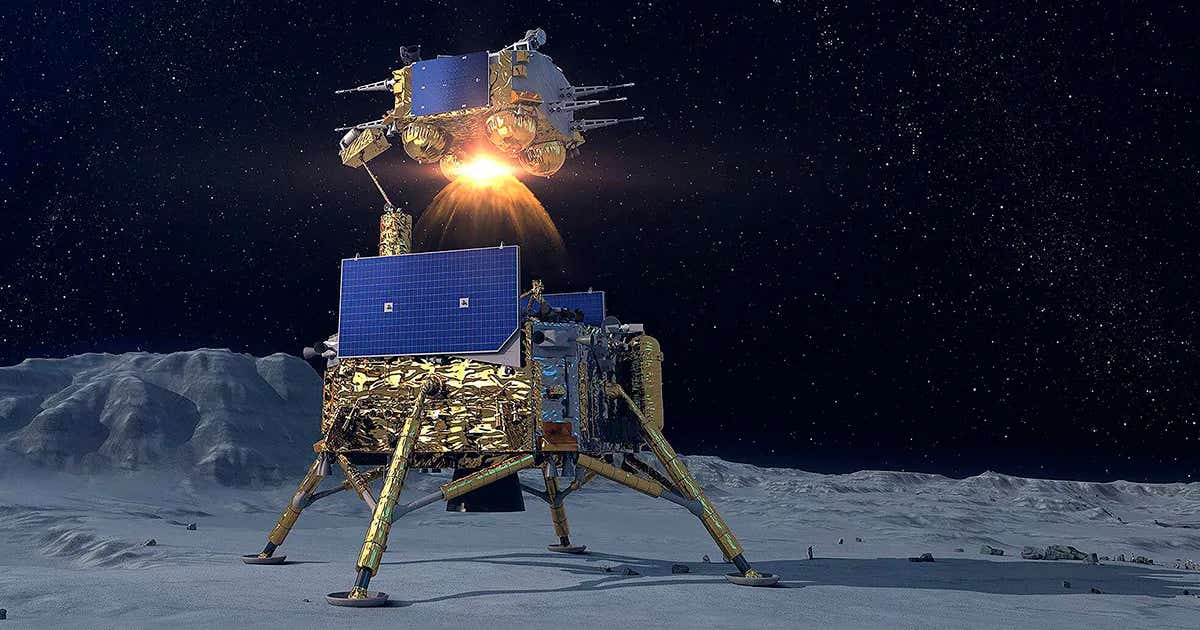Chang’e-6 samples show ancient lunar impacts left rust on the Moon
New Chang’e-6 samples show hematite formed by ancient lunar impacts, reshaping ideas about Moon chemistry.

 Edited By: Joseph Shavit
Edited By: Joseph Shavit

A new study of Chang’e-6 soil samples reveals micrometer-scale hematite formed in ancient lunar impact plumes, shifting long-held views of Moon chemistry. (CREDIT: Wikimedia / CC BY-SA 4.0)
For more than half a century, scientists pictured the Moon as an almost fully reduced world where iron stayed locked in low-oxygen states. That idea came from Apollo samples, which showed that solar wind bombardment and a lack of free oxygen kept minerals in reduced forms and left little room for rustlike phases to survive. A simple picture took hold: the Moon’s surface was too harsh, too oxygen poor and too stripped by particle radiation for minerals such as hematite to develop naturally.
Fresh evidence from China’s Chang’e-6 mission has now unsettled that view. A new study reports the first confirmed discovery of crystalline hematite and maghemite in lunar soil collected from the farside’s South Pole–Aitken Basin. The finding suggests that oxygen-rich pockets once existed on the Moon, likely created during enormous impact events that briefly transformed local conditions. It also hints that these oxidized minerals could be tied to puzzling magnetic features around one of the oldest impact basins in the Solar System.
A Shift in a Longstanding Story
For decades, scientists believed the Moon formed from Earth’s mantle material after a violent collision with a Mars-sized body. The Moon’s interior chemistry matched that story, but its surface environment, shaped by low oxygen levels and a constant stream of solar particles, left little room for oxidized minerals. Occasional hints of ferric iron phases in Apollo samples were later dismissed as contamination that formed when rocks returned to Earth.
Even orbital data that seemed to show hematite near the poles stirred debate. A few teams suggested that drifting oxygen from Earth’s upper atmosphere might oxidize lunar iron over millions of years. Others questioned the data itself. Despite the arguments, no one had found truly unambiguous mineralogical proof that hematite had formed on the Moon.
That gap is what makes the Chang’e-6 discovery so meaningful. The research team, led by scientists from the Institute of Geochemistry at the Chinese Academy of Sciences and Shandong University, identified micrometer-scale ferric iron particles in a three-gram soil sample. These grains were confirmed using Raman spectroscopy, transmission electron microscopy and electron energy loss measurements.
What the Samples Reveal
Inside the soil, the researchers found nine tiny grains containing ferric iron. One of the samples, housed in a breccia fragment, included a hematite crystal only a few micrometers across. High-resolution images showed it perched on a troilite grain. When the team cut a hair-thin slice through the region, they saw a layered structure: hematite sitting on troilite, with magnetite and maghemite bridging the boundary between the two.
Energy-dispersive x-ray maps showed sharp separation between the minerals, proving the ferric iron phases formed after the sulfide. The hematite grain carried a thin, glassy coating made of silicon and oxygen that lacked other major elements. That coating likely condensed from a vapor cloud rather than forming by later chemical alteration. Lattice patterns in the hematite matched known crystal structures, including the distinctive spacing of the (012) and (104) planes. Meanwhile, the iron’s oxidation state matched pure Fe³⁺ in parts of the grain and mixed valence states at the interface.
This level of detail leaves little room for contamination. These minerals formed on the Moon, not in a lab or during transport.
How Impacts Created Rust in a Low-Oxygen World
The most likely explanation points to large impacts. When a massive object strikes the Moon, temperatures can rise above 700 degrees Celsius. Minerals break apart, releasing oxygen into a hot, turbulent plume. Even on a reduced world, these violent events can momentarily push conditions into an oxidizing regime.
In that environment, troilite can lose sulfur and release iron, which then reacts with the newly freed oxygen. As the plume cools, iron condenses back onto nearby grains and forms ferric oxides. The Chang’e-6 samples sit in a region shaped by countless large impacts over billions of years, making it an ideal site to capture minerals forged in these short-lived oxidizing bursts.
The temperatures recorded in the sample suggest a sweet spot: hot enough to remove sulfur and oxidize iron, but not hot enough to break down nearby ilmenite. This matches conditions expected at the margins of a large impact plume.
Why These Minerals Survived for Billions of Years
If impacts can create hematite, the next question is why earlier missions never found it. The answer may lie in location and preservation.
Most Apollo and Luna missions landed on the nearside, where young lava flows cover much older impact deposits. The Chang’e-6 site sits on the lunar farside, inside the South Pole–Aitken Basin. This area has fewer volcanic layers and better preserves ancient materials.
The site also receives less solar wind than equatorial regions. Because solar wind particles can reduce Fe³⁺ back to Fe²⁺, a weaker flux helps ferric iron survive. Magnetic anomalies around the basin may offer even more shielding by redirecting charged particles. The presence of maghemite, a strongly magnetic mineral, may even help explain how those anomalies formed.
How Scientists Confirmed the Discovery
The team used a suite of tools to build the full story. Raman spectroscopy identified grains with ferric signatures. Electron microscopes revealed crystal shapes and boundaries. Energy loss spectroscopy measured oxidation states with pinpoint accuracy. Thermodynamic modeling helped test whether impact conditions could produce the minerals found.
Every method pointed to the same conclusion. The Moon’s surface has hosted brief moments of oxidation powerful enough to produce hematite and maghemite, and the Chang’e-6 samples captured those traces.
Practical Implications of the Research
These findings reshape how you understand lunar evolution. The presence of ferric minerals means the Moon’s surface chemistry is more dynamic than once believed.
The work gives scientists a clearer view of how giant impacts influence planetary surfaces and offers new clues about the origin of lunar magnetic anomalies. It also helps future explorers know where to look for oxidized resources that could support long-term missions.
More broadly, the research shows that even airless bodies can host surprising chemical changes when impacts provide the right conditions.
Research findings are available online in the journal Science Advances.
Related Stories
- Moon dust from Chang’e-6 mission reveals asteroids carried water to Earth
- Moon's largest impact crater helps explain why the near side and far side look so different
- Planetary scientists reveal how the Earth and Moon actually formed
Like these kind of feel good stories? Get The Brighter Side of News' newsletter.
Joshua Shavit
Science & Technology Writer and Editor
Joshua Shavit is a Los Angeles-based science and technology writer with a passion for exploring the breakthroughs shaping the future. As a co-founder of The Brighter Side of News, he focuses on positive and transformative advancements in AI, technology, physics, engineering, robotics and space science. Joshua is currently working towards a Bachelor of Science in Business and Industrial Engineering at the University of California, Berkeley. He combines his academic background with a talent for storytelling, making complex scientific discoveries engaging and accessible. His work highlights the innovators behind the ideas, bringing readers closer to the people driving progress.



